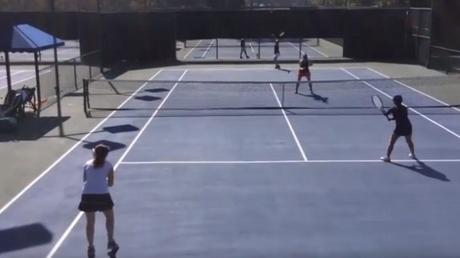
Don't you just hate when you're playing doubles and serving to the ad court, and your opponent constantly rips a cross-court winner to your backhand? It's SO frustrating!
Most doubles players have a weaker (sometimes MUCH weaker) backhand, and if that is constantly being exploited when you serve, use the Australian formation as it will force your opponents to play to your strength...your forehand. And you can also use it to mess with your opponent!
What is the Australian formation?
Similar to the I-formation, this tactic changes up the look of the court and mentally messes with your opponents. It's easier to do than the I-formation, too. Both players on the serving team position themselves on the same side of the center line, but unlike the I-formation, the net player doesn't have to crouch down, and he/she stays on the same side, unless of course, there is a poaching opportunity.
**This is considered a more advanced tactic, however, that doesn't mean lower level players (3.0 and under) can't learn to do it. Perfect it in your practice matches, and then let the intimidation begin in league :)
Scenarios in which you should use the Aussie formation:
The Australian formation is a great way to manipulate the return.
Disable a strong cross-court return on the ad side. The ad side is where the important points are served (40-0, 0-40), so if you have a weak backhand, and your opponent can consistently rip angled cross-court returns for winners, it's crucial that you take that opportunity away by forcing him/her to return down the line to your stronger forehand.
Create poaching opportunities for your partner. If your partner is a monster at the net, use the Australian to help set up poaching opportunities. Since your partner will be expecting the ball to go down the line, he/she will be ready to take a step or two for that put-away volley.
Use it because you can. You don't have to have a reason to change things up...just do it. It will mess with their mental game, and the more they worry about what you might do next, the less they think about their own game.
Where to place your serve:
Because you are leaving half of the court open when using the Australian format, it's important that you serve with pace, and are able to place the ball well.
The ideal placement is either deep into the body (more to the backhand side) or out wide to their backhand. The serve into the body will jam the returner, producing a weak, possibly poachable return. The serve out wide will force the opponent to change the direction of the ball and hit it down the line, which is somewhat difficult to do with accuracy.
If the ball comes back, it will be to the server's forehand, and much easier to control. Be patient and keep hitting deep to the receiver's backhand, making sure you have enough height to clear the highest point of the net, and enough topspin to keep the ball in. With enough patience, your opponent will likely break down and make an error, or return a floater that either you can come in on or your partner can poach.
How to respond to the Australian formation:
Should your opponents beat you to the Australian, there are some things you can do that will make them think twice about doing it again.
Run around the serve. So many times I've seen a receiver wait for a slower serve and take it with their backhand when they could have run around it and taken with their forehand. DON'T DO THAT. Any time you see that the serve is slower and to the backhand or body in the ad court, take a quick step or two to the left so you can use your forehand to punish your opponents down their line.
Don't be afraid to lob. Send the ball back to the server, deep to their corner on the ad side. This will not only get the court formation back to a more normal look but hopefully will result in a short lob return from the server that either you or your partner can put away.
Enjoy your doubles and keep in mind that a "change-up" at times can be very effective. Those court changes allow you to take control by neutralizing your opponent's strengths and exploiting their weaknesses...so you can win more points!

